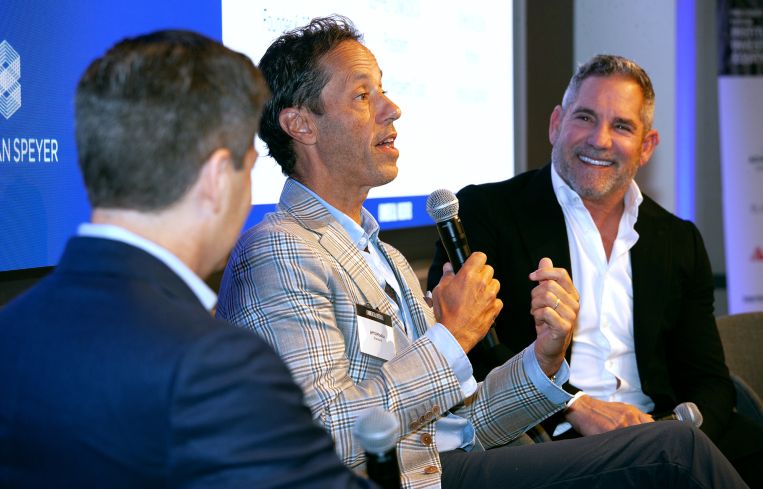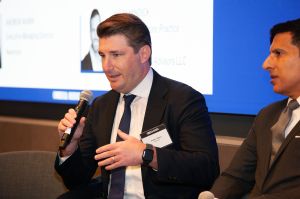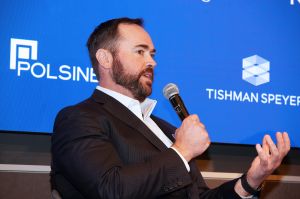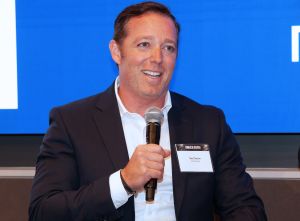How Commercial Real Estate Investors View Capital Markets in 2025
The industry’s biggest names discussed all aspects of CRE investment — especially private capital — during a recent Commercial Observer forum.
By Brian Pascus September 12, 2025 1:31 pm
reprints
A room of top commercial real estate experts held court on everything from cryptocurrency and family offices to the future of interest rates and artificial intelligence during Commercial Observer’s National Institutional Investor & Private Equity Forum.
The symposium, held Sept. 10 at 237 Park Avenue in Midtown Manhattan, opened with a general discussion between Jeff DiModica, president of Starwood Property Trust, and Grant Cardone, founder and CEO of Cardone Capital, hosted by John D. Wilson, partner at King & Spalding.
DiModica admitted that Starwood, with $30 billion in assets, will have record origination volume in 2025, but that the industry is nowhere near the transaction levels and refinance levels of 2021. He noted that U.S. market transaction volume has declined from $680 billion to $450 billion in one year, but that a ton of money has still been raised for debt in this up-and-down current cycle.
“We’re all trying to raise capital as quickly as we can to grow into this opportunity, spreads are super tight which has been hard, but banks are lending to us at spreads that are tighter than they ever had,” DiModica said. “It’s very difficult to raise money for equity, whereas for the debt side, ever since that [interest rate] move, we can create a mezzanine at 12 or 13 percent.”
Cardone said that this is the best time to buy real estate in his entire career, and that many investors are entering the CRE space through cryptocurrency. Cardone documented how his firm has added cryptocurrencies like bitcoin into capital stacks by buying physical real estate below replacement cost and adding the cryptocurrency with cash, pushing the two together into one investment branch to provide his firm with constant liquidity via bitcoin and the illiquidity of the hard real estate asset cash flow.
“We have the stability of the real estate, with the cash flow and depreciation of the tax write-offs, and we combined the percentage of bitcoin to it,” he said. “We showed this to investors as something that would go from a 12 or 15 percent return to a possible 25 or 35 percent return. … The response by the market was phenomenal.”
The duo also spoke on the current interest rate climate, with Cardone blaming “Jerome ‘Too Late’ Powell,” as he called him in a nod to President Donald Trump, for failing to cut rates quick enough. DiModica said that if the Federal Reserve chooses to lower the short-term rate too quickly in the coming months, it could destabilize the long-term 10-Year Treasury yield.
“Being a market practitioner and having grown up in bond sales and trading, I know that if you force the federal funds rate from 4.25 [percent] to 0, then the 10-Year Treasury will go from 4 percent to 5 percent or 6 percent or something higher,” he said. “As soon as the market starts to think you’ll lower more quickly than the forward curve, the 10-Year by definition should shoot up and create inflation.”

The next discussion, hosted by Mark Mindick of Citrin Cooperman Advisors, focused on the lessons learned in 2025 and capital markets projections for the months ahead.
Andrew Warin, executive managing director at Newmark, said there’s less reluctance today from his clients to launch equity recapitalizations and engage in transactions compared to 12 to 18 months ago, and that the bevy of novel capital solutions strategies — whether they are general partners stacks, GP-led secondary funds or net asset value loans — are now growing in use and adaptability.
“There’s just a number of capital formation strategies available to our clients that did not exist five to 10 years ago, and a tremendous amount of money has been raised for these strategies,” he said.
Abbe Franchot Borok, head of U.S. debt at BGO, noted that the last 18 months has seen “a disciplined approach to investing,” and that she expects to see transaction volumes pick up, particularly in the value-add, senior and stretch senior secured lending space.
“It just really continues to open the space for alternative lenders and debt funds, who’ve become such an accepted segment of the real estate debt capital markets,” she said. “We are seeing some green shots there on the acquisition and development side.”
Jeanette Abate, managing director at Tishman Speyer, pointed out that her development firm has closed $7 billion worth of commercial mortgage-backed securities (CMBS) deals in the last 12 months. And while 2023 was the lowest volume of U.S. CMBS since 2011, last year saw that metric double, Abate said, and in 2025 the U.S. real estate industry has already closed $75 billion worth of CMBS loans.
“It’s on track to be a banner year,” she said. “A functioning CMBS market is really important to the overall liquidity of the commercial real estate system.”
But it’s not all green shoots. Andrew Dansker, CEO of Dansker Capital Group, emphasized that the compression of spreads in the world of debt funds is indicative perhaps of too much capital flowing into that space, while the world of commercial banking has “a serious capital availability issue,” that hasn’t yet revealed its true, dare we say awful, significance.
“Transaction volume is still so depressed, but I think there’s a serious issue in terms of banks’ ability to lend,” Dansker said. “When the transaction volume does finally pick up, we’ll see that.”
Sam Chandan, the founding director of the Chen Institute for Global Real Estate Finance at New York University’s Stern School of Business, said that he’s less concerned with inflationary pressure resulting from tariffs. Instead, he’s more concerned about the potential downside across the labor market as it relates to consumers’ ability to participate in driving economic activity forward, especially in regard to both short-term and long-term interest rates.
“If we move too aggressively in the short term over the short curve, the Federal Reserve has no control over the long end,” Chandan said. “For most of us in the room, the 10-Year will matter much more than the federal funds rate target.”
Before a short networking break, Leo Jacobs, founder of Jacobs P.C., hosted a symposium concerning the rise of alternative financing.

Scott Crowe, executive vice president at RXR, described a structural shift that has occurred across the lending industry, with banks becoming more risk averse, especially after the regional banking crisis of 2023, and that amid the several bank failures, the banks left standing have opted for loan-on-loan financings with debt funds rather than direct lending into real estate projects.
“Banks are trying to get out of the real estate business. They’d rather lend to us and be in the safe part of capital stacks and leave the higher loan-to-values (LTV) behind and get closer to the equity, “ he said. “They’d rather see groups like ourselves take this risk.”
Nicholas Baccile, director at Canyon Partners Real Estate, agreed with Crowe and added that debt funds and private credit shops can provide a more “hands-on” approach to lending and workouts than their commercial competitors, who are often partners.
“A lot of it is risk transfer,” he said. “It’s a two-way street: We get their borrowing relationships, they get ours, and there’s a symbiosis of capital because they don’t want to go up to 70 percent LTV.”
Natalia Sosnina, head of acquisitions at Terra Strategies, spoke to the fact that most private lending, due to its exit strategies, is shorter term than traditional bank loans, which have 10-year timelines, while Steven Parrinello, managing director at Fortress Investment Group, placed emphasis on the fact that banks will always play a part in CRE lending, but it will be more indirect going forward and at lower leverage points.
“When it comes to private credit, a tremendous amount of capital has been raised, and over the last 60 to 90 days, competition is pretty fierce,” Parrinello said. “And you’ve seen private credit come back into [originations] for parts of the market they weren’t even lending in.”
After a short break, Jen Recine, partner at King & Spalding, moderated a discussion with Christina Minnis, global head of credit and asset finance and head of global acquisition finance at Goldman Sachs, where the focus of the conversation was, once again, on private credit.
Minnis noted that private credit is coming up on $1 trillion in assets, and while it’s still smaller than liquid public markets, it’s rapidly growing in size, with major consequences for the industry as a whole.
“It’s increasing at 30 percent annual growth rate, while the established public markets are growing in mid-to-single digits,” Minnis said, noting that the two markets are blending together in both pricing and structure. “The convergence is happening for the primary reason that there’s just not a lot of net new supply for either the private credit market or the public markets to invest in.”

The next discussion, hosted by Sonia Kaur Bain, partner at Blank Rome, examined current investment strongholds — namely multifamily, retail and data centers — as a new class of safe havens for capital.
Teodora Zobel, chief investment officer of Midwood Investment and Development, admitted “there’s a ton” of investor appetite for stabilized multifamily and retail. But it’s not so much in development, she said, as there’s still a gap in common equity for those deals. Instead, there’s appetite for operating already stabilized assets.
“Rents grow at a surprisingly high rate for an extended period of time — rent growth was 5.5 percent in New York and close to 10 percent in Philadelphia and Pittsburgh,” she said. “We think it’s great that some of these asset classes are back in favor.”
Evan Abraham, assistant vice president for investment in New York at InterVest Partners, agreed with this sentiment, pointing out that the multifamily supply pipeline is “the best it’s been in quite a while,” and this has allowed investors to take calculated risks because it’s a risk on an asset class that has the most predictable liquidity.
“If I can feel confident about liquidity going in, from a financing perspective … knowing there is someone there that will lend, refinance, or give us some price to buy is a very comforting thing,” he said.
Michael Hunter Coghill, managing partner and founder of Adirondack Capital Partners, immediately agreed, adding that the depth of liquidity in the housing sector makes it “hands down the safest sector to be in today.”
“We have seen multifamily trade at significant premiums compared to other asset classes and we anticipate that to continue as capital markets recalibrate,” he said.
Steven Binswanger, senior managing director at JLL, played the contrarian and emphasized the best investment opportunities are within data centers.
He said that data centers provide an outsize yield from “the best credit tenants in the world” — namely, bullet-proof hyperscalers like Amazon and Microsoft, and that newly developed data centers typically generate 7 percent to 8.5 percent cap rates, while taking no risk on leasing if powered land is already in place.
“The cash flow that these things are printing, especially if interest rates come down, is huge,” he said. “There’s a huge opportunity — the smartest people in our business have already jumped on it and put hundreds of billions of dollars into it.”
A second one-on-one session then commenced with CO Executive Editor Cathy Cunningham interviewing Miles Treaster, president of Americas capital markets at Cushman & Wakefield, where the conversation prioritized the rise of investment capital pivoting into alternative asset classes.
Treaster argued that data centers, self-storage, cellphone towers and other formerly esoteric asset classes have, on margin, performed much better than traditional asset classes like office, hospitality and retail.
“When you think about alternatives and capital formation, that’s where you’ll see most of the money go into, but it still represents a small amount of investment in commercial real estate,” he said. “So you have to be cognizant of the fact that this is something that will probably take some time to expand.”
Treaster also touched on the fact that today, even amid persistently higher interest rates, the growth of private credit has created almost too much credit in a system flush with debt, leaving deals to scrounge up whatever equity they can find to fill capital stacks.
“There’s not a problem with credit today. There’s more credit than there’s ever been,” he said. “The problem is fickle equity.”
Treaster also weighed in on some notable trends he’s seeing today, including the proliferation of continuation vehicles as firms seek to hold assets for longer when no appetizing exit strategy is in sight, and the consolidation of managers.

After another short networking break, John Vavas, co-head of New York real estate at law firm Polsinelli, led a discussion on how industry leaders are managing broader investment allocations, and where commercial real estate stands in that mix.
Julie Ingersoll, chief investment officer at CBRE Investment Management, said that while many limited partners have had their CRE allocations reduced by CIOs from 10 percent to 7 percent, there is latent optimism surrounding what the Federal Reserve might do in the near future regarding short-term rate cuts to help the real estate selector.
“If that happens, maybe we can save some of 2025 in terms of capital raising and investment activity, but we are not putting too much hope on short-term cuts generating meaningful impact on the long term,” she said. “Sorry for the wet blanket here.”
Brian Pieracci, managing director and head of private equity North America at investment manager Heitman, echoed Ingersoll’s sentiment. He said that the CRE investment sphere hasn’t recovered since Donald Trump’s Liberation Day tariffs announcement in April altered the entire economy, and that amid so much heightened uncertainty investors have poured into safer cash-flow investments via core and core-plus debt and equity transactions.
“They’ve admitted they went up the risk spectrum and got burned in many cases,” Pieracci said. “Which is why the immediate pivot is private credit. It’s a protected position with similar returns and less risk.”
Michael Hyun, chief investment officer at Crow Holdings, said the real estate sector as a whole has authored many self-inflicted wounds, from developing too much supply in oversaturated markers to not hedging interest rate risk when rates were low, to not selling enough assets in the boom years of 2021 and 2022 to generate return for investors.
“Real estate has not done a great job of delivering returns,” he explained. “Look at the public markets as a proxy: Real estate is the second-worst performer on a one-year basis and the worst performer on a three- to five-year basis. We’re not the prettiest girl at the dance.”
Tal Peri, head of the U.S. East Coast and Latin America at Union Investment Real Estate GmbH, tried to be a bit more positive, and said that in the last 12 months or so every week, every month, new players have come back into the market on both the debt and equity sides, particularly in New York City office deals.
The final discussion of the day focused exclusively on how family offices are adapting investment strategies in a dynamic market climate. The talk was moderated by Seth Niedermayer, partner at HSF Kramer.

Saul Sutton, managing partner at Catal Group, curbed expectations a bit for those looking to enter the family office business by pointing out the typical family office investment firm needs a minimum of $500 million in capital to operate effectively.
“Otherwise the cost of running it is too expensive, and that comes to why family offices are looking to raise money in certain strategies,” he said. “To get really good people, you need to pay them and incentivize them.”
Alec Raggio, head of acquisitions and asset management at Gindi Equities, said that family offices today have evolved from passive investors who merely write lucrative checks to big-name sponsors into take-charge generals who want to direct where the investment capital flows.
“The second and third generations of family offices want to raise outside capital and participate in different fee structures,” he said. “More big-ticket check writers want better economics, a better say and more control.”
Rachel Loeb, chief investment officer at Benenson Capital Partners, said her investment firm has worked with family offices recently to not only reposition assets but to buy empty land as well.
“Where can you take where there’s literally no basis, not much cash flow and convert that into a higher and better use? That’s one of the strategies we’re employing, being land rich,” Loeb said.
Tim Richards, co-head of conduit originations at Goldman Sachs, said that investment banks can support family offices by sourcing investment opportunities – particularly when it comes to private capital.
“There is a lot of opportunity in private capital right now, but the question for family offices is how are you sourcing those opportunities. At Goldman Sachs, we facilitate and have access to a large number of private credit deals over the course of a year. With such a large funnel and embedded relationships we can work with Family Offices to provide opportunities and access to the interesting deals that they may not otherwise get to see.”
Brian Pascus can be reached at bpascus@commercialobserver.com.


